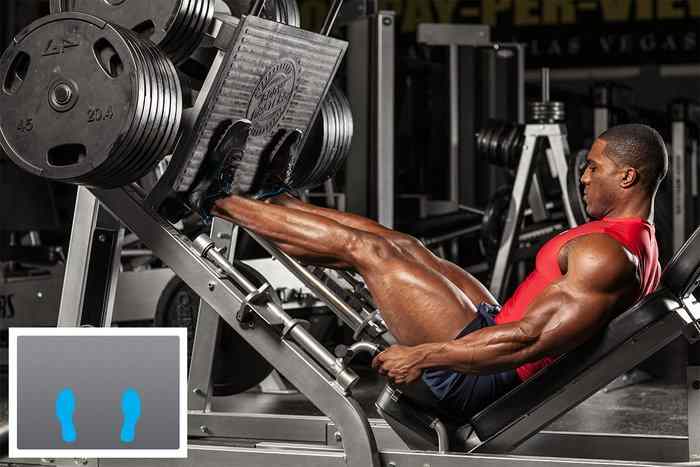Introduction
Welcome to our comprehensive guide on dynamic stretching for hamstrings, a practice that can help you achieve flexibility, improve performance, and alleviate discomfort. Whether you’re an athlete seeking to enhance your performance or an individual dealing with tight hamstrings and related issues, this article will provide you with valuable insights and actionable exercises to stretch and strengthen your hamstrings effectively.
Understanding Hamstrings and the Importance of Stretching
Hamstrings are the muscles located at the back of your thigh, and they play a crucial role in various lower body movements like walking, running, and jumping. So, it’s important to keep them happy and healthy!
SHOP FOR THE BEST QUALITY RESISTANCE BAND ON AMAZON
Stretching your hamstrings is essential because tightness in these muscles can limit your range of motion and cause discomfort. But fear not! Incorporating stretching into your routine can make a world of difference.
By stretching your hamstrings, you can increase flexibility, improve performance, and even alleviate lower back pain. It’s like giving your hamstrings a loving hug and saying, “Hey, we’re in this together!”
So, let’s dive into the wonderful world of hamstring stretching and unlock the secrets to happier, more flexible legs!
Dynamic Stretching: The Key to Loosening Tight Hamstrings
What is Dynamic Stretching?
Dynamic stretching involves moving your muscles through a full range of motion in a controlled manner. Unlike static stretching, where you hold a stretch for an extended period, dynamic stretching aims to mimic the movements you’ll perform during your workout or daily activities. This type of stretching is particularly beneficial for warming up before physical activity and improving muscular performance.
SHOP FOR THE YOGA MATS ON AMAZON
Benefits of Dynamic Stretching for Hamstrings
Dynamic stretching for hamstrings offers numerous advantages, including:
- Improved Flexibility: Dynamic stretching helps increase the flexibility of your hamstrings, allowing for a greater range of motion during physical activities and everyday movements. Say goodbye to feeling stiff and restricted!
- Enhanced Athletic Performance: By incorporating dynamic stretches into your warm-up routine, you activate and prepare your hamstrings for the demands of your chosen sport or exercise. This can lead to improved performance and better results in your athletic endeavors.
- Injury Prevention: Tight hamstrings can increase the risk of strains and pulls, especially during physical activities that involve explosive movements or sudden changes in direction. Dynamic stretching helps loosen your hamstrings, reducing the likelihood of these injuries and keeping you in the game.
- Efficient Muscle Activation: Engaging in dynamic stretching exercises before your workout or physical activity activates and primes your hamstrings. This increased blood flow and muscle activation can optimize their performance, ensuring they’re firing on all cylinders.
- Reduced Muscle Soreness: Dynamic stretching after a challenging workout can help alleviate muscle soreness and promote faster recovery. It aids in flushing out metabolic waste products and enhances the delivery of nutrients to your hamstrings, facilitating the healing process.
- Improved Posture and Lower Back Health: Tight hamstrings can contribute to poor posture and lower back pain. By incorporating dynamic stretches into your routine, you can gradually release tension in your hamstrings and promote better alignment, thereby alleviating discomfort in your lower back.
- Enhanced Functional Movement: Dynamic stretching mimics the movements you perform in daily life and sports. By practicing these stretches regularly, you improve your functional movement patterns, making activities like bending, reaching, and lifting easier and more efficient.
Preparing for Dynamic Stretching
To make the most of your dynamic stretching routine, it’s essential to prepare properly. Start by wearing comfortable workout attire and ensuring you have enough space to move around freely. Begin with a light cardiovascular warm-up, such as brisk walking or light jogging, to increase blood flow to your muscles. This will help loosen them up and optimize the benefits of dynamic stretching.
Dynamic Stretches for Hamstrings
Let’s explore some effective dynamic stretches specifically designed to target and loosen your hamstrings. Remember to perform these exercises in a controlled manner, focusing on maintaining proper form and avoiding any sharp or sudden movements.
1. Standing Dynamic Hamstring Stretch
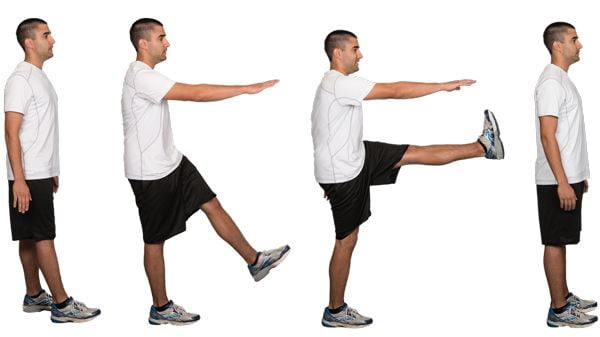
Start by standing tall with your feet hip-width apart. Lift one leg straight in front of you, keeping it extended. As you lower the lifted leg, swing it back behind you, simultaneously reaching forward with the opposite arm. Repeat this movement on each side for 10-12 repetitions, gradually increasing the range of motion with each swing.
2. Walking Lunge with Hamstring Stretch
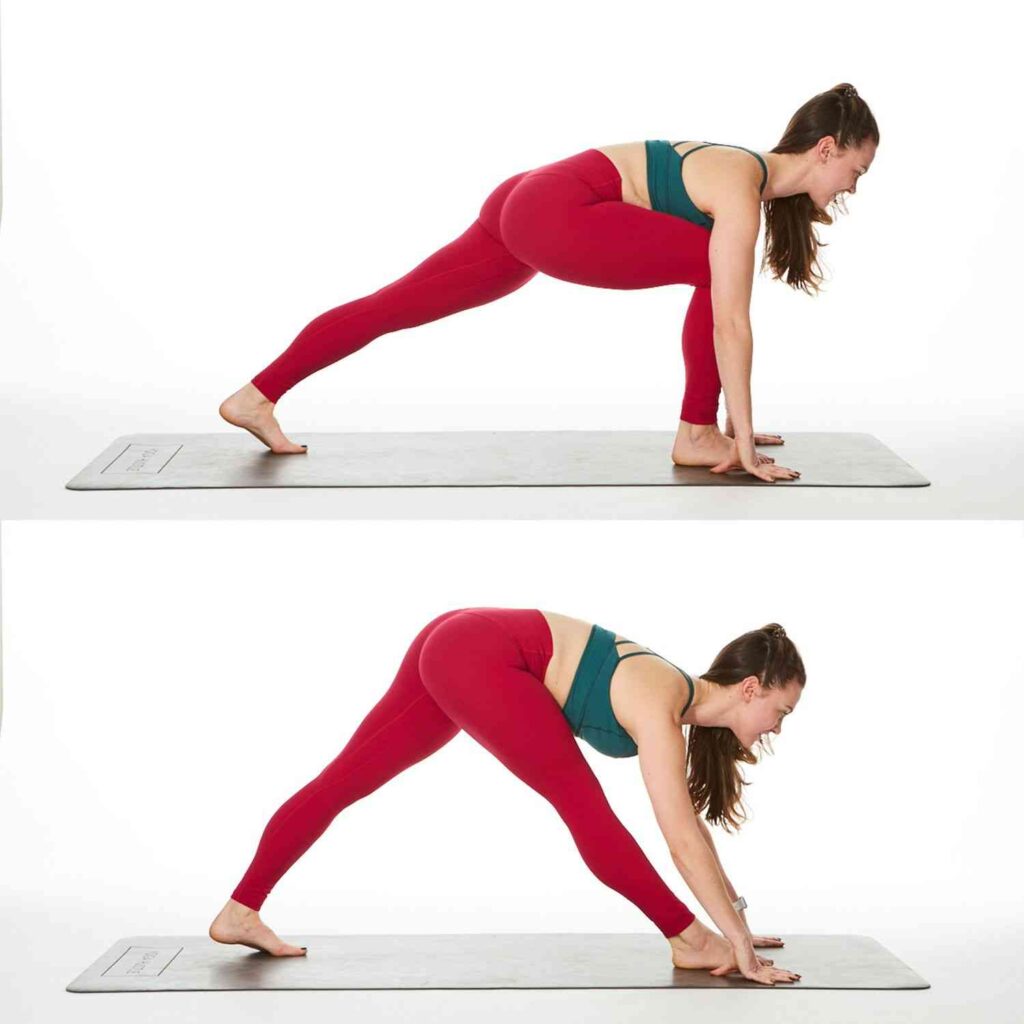
Begin with a standing position, take a step forward with your right leg, and lower your body into a lunge position. While in the lunge, extend your arms overhead and lean your upper body slightly backward. Push off with your right foot, bringing it forward and stepping into the next lunge with your left leg. Repeat this walking lunge pattern for a total of 10-12 lunges.
3. Leg Swings
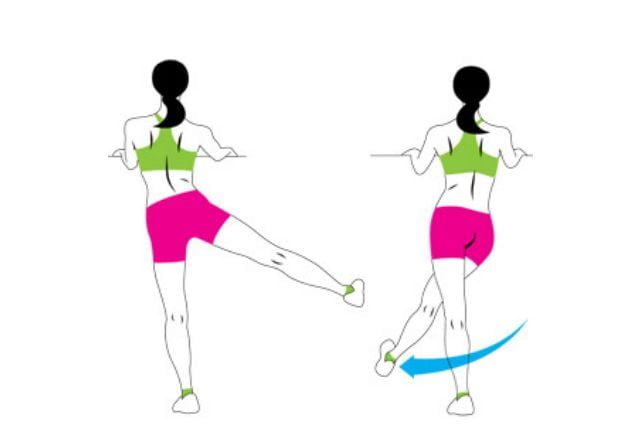
Find a sturdy support, such as a wall or a pole, and face it sideways. While holding onto the support with one hand, swing your opposite leg forward and backward in a controlled manner. Aim for 10-12 swings on each leg, gradually increasing the range of motion as you progress.
4. Single-Leg Deadlifts
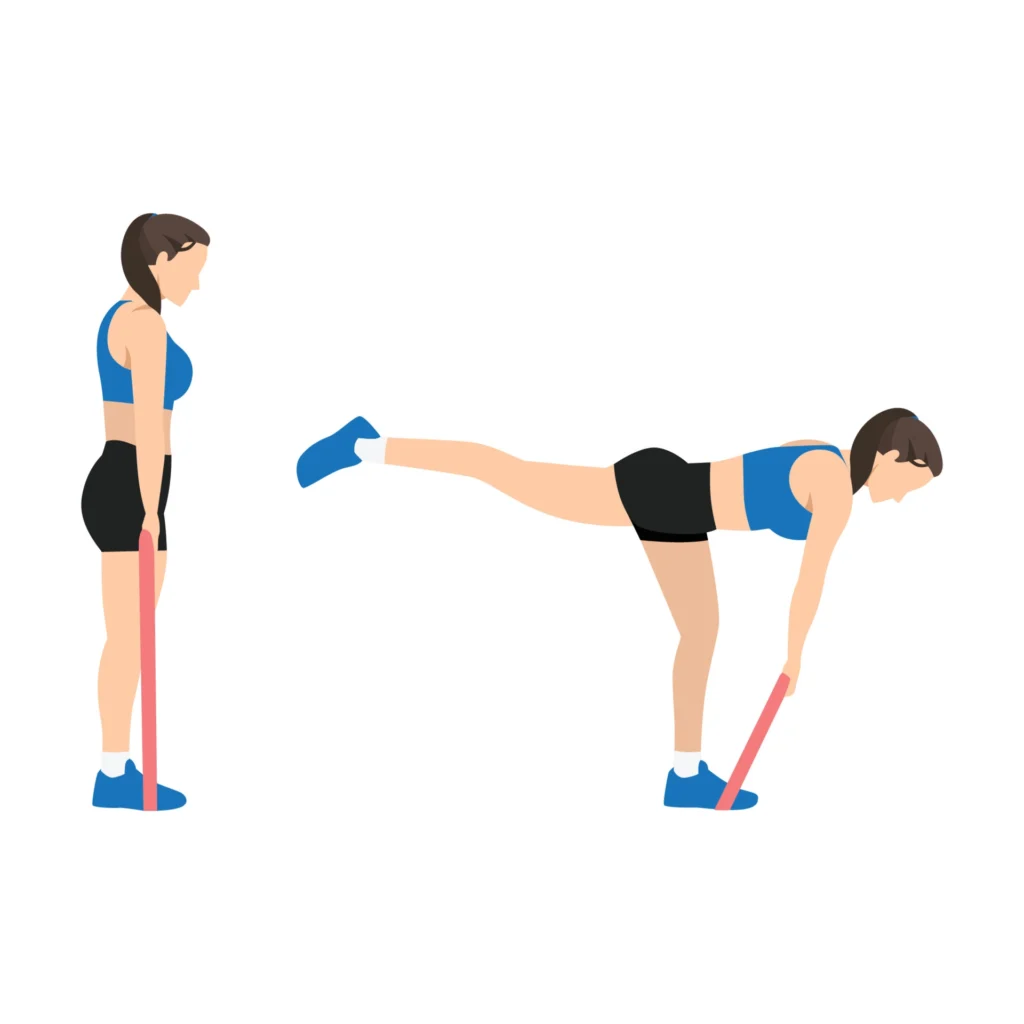
Stand tall with your feet hip-width apart. Lift one leg slightly off the ground, extending it straight behind you while simultaneously lowering your upper body toward the floor. Keep your back straight and engage your core for stability. Return to the starting position and repeat on the opposite side. Perform 10-12 repetitions on each leg, focusing on balance and control.
5. Yoga Poses for Stretching Hamstrings
Yoga offers a holistic approach to flexibility and strength. Incorporating specific yoga poses into your routine can effectively target and stretch your hamstrings. Some beneficial poses include Downward Dog, Standing Forward Bend, and Wide-Legged Forward Fold. Explore these poses with proper guidance and gradually deepen your stretch as your flexibility improves.
The Role of Nutrition in Hamstring Health
When it comes to maintaining optimal hamstring health, nutrition plays a crucial role. Proper nutrition provides the essential building blocks for muscle repair, growth, and flexibility. Here are some important aspects of nutrition to consider for the health of your hamstrings:
Essential Nutrients for Muscle Health
a. Protein: Adequate protein intake is vital for muscle repair and growth. Include lean sources of protein in your diet, such as chicken, fish, tofu, beans, and Greek yogurt. Aim for a balanced distribution of protein throughout the day to support optimal muscle recovery.
SHOP FOR THE BEST QUALITY PROTEIN POWDER ON AMAZON
b. Omega-3 Fatty Acids: These healthy fats have anti-inflammatory properties that can help reduce muscle soreness and promote muscle health. Include fatty fish like salmon, sardines, and mackerel, as well as chia seeds, flaxseeds, and walnuts in your diet.
c. Antioxidants: Antioxidants help combat oxidative stress and inflammation, which can contribute to muscle damage. Include colorful fruits and vegetables, such as berries, citrus fruits, spinach, kale, and bell peppers, in your meals.
d. Vitamin D: Adequate levels of vitamin D are essential for muscle function and overall musculoskeletal health. Include foods rich in vitamin D, such as fatty fish, fortified dairy products, and egg yolks. Additionally, exposure to sunlight can help your body produce vitamin D naturally.
Foods that Promote Flexibility and Muscle Recovery
a. Magnesium-Rich Foods: Magnesium is involved in muscle relaxation and flexibility. Incorporate foods like dark leafy greens, nuts, seeds, whole grains, and bananas into your diet to ensure sufficient magnesium intake.
b. Collagen-Rich Foods: Collagen is a structural protein that provides support and elasticity to tissues, including muscles and tendons. Include collagen-rich foods like bone broth, lean meats, fish, and collagen supplements in your diet.
SHOP FOR THE COLLAGEN POWDER ON AMAZON
c. Hydration: Staying properly hydrated is essential for muscle health and flexibility. Aim to drink an adequate amount of water throughout the day and consider incorporating hydrating foods like watermelon, cucumber, and citrus fruits.
d. Balanced Macronutrients: Ensure you have a balanced diet that includes carbohydrates for energy, lean proteins for muscle repair, and healthy fats for overall health. Opt for whole grains, lean meats, fish, legumes, and healthy fats from sources like avocados, olive oil, and nuts.
It’s important to note that nutrition alone cannot guarantee optimal hamstring health. It should be complemented with a regular stretching and exercise routine. By combining proper nutrition with dynamic stretching exercises, you can provide your hamstrings with the necessary support for flexibility, strength, and injury prevention. Consult with a healthcare professional or registered dietitian to personalize your nutrition plan based on your specific needs and goals.
Incorporating Dynamic Stretches for Hamstrings and Calves
The hamstrings and calves work synergistically to support lower body movements. Therefore, it’s important to address both muscle groups when designing your stretching routine. Here are a few dynamic stretches that combine hamstring and calf stretches:
1. Calf Raises with Dynamic Hamstring Stretch
Start with your feet hip-width apart, and slowly raise your heels, lifting your body onto the balls of your feet. As you lower your heels back to the ground, extend one leg straight in front of you, aiming to touch your toes with your hand. Alternate legs with each repetition and perform 10-12 calf raises.
2. Downward Dog with Calf Stretch
Assume a push-up position, with your hands slightly wider than shoulder-width apart and your feet hip-width apart. Push your hips up and backward, forming an inverted “V” shape with your body. While in this position, alternate bending one knee and pressing the opposite heel toward the ground to stretch both your hamstrings and calves. Repeat this movement for 10-12 repetitions.
3. Alternating Lunges with Calf Stretch
Begin by standing tall with your feet hip-width apart. Step forward with your right leg into a lunge, ensuring your knee is directly above your ankle. While in the lunge position, lift your right heel off the ground, stretching your calf. Push off with your right foot, bringing it back to the starting position, and repeat the lunge on the opposite side. Perform 10-12 alternating lunges, incorporating the calf stretch in each repetition.
Stretching Hamstrings to Alleviate Lower Back Pain
The hamstrings and lower back are interconnected, and tight hamstrings can contribute to lower back pain. By incorporating dynamic stretching into your routine, you can help alleviate discomfort and promote lower back health.
1. The Hamstring-Back Connection
The hamstrings attach to the pelvis and play a crucial role in maintaining proper posture and alignment. When the hamstrings are tight, they can pull on the pelvis, leading to an increased curvature of the lower spine and potentially causing lower back pain.
2. Dynamic Stretches to Relieve Lower Back Pain
Performing dynamic stretches for the hamstrings can help relieve lower back pain. Engage in exercises like the Standing Dynamic Hamstring Stretch, Leg Swings, and Single-Leg Deadlifts mentioned earlier. These stretches not only target the hamstrings but also promote proper pelvic alignment and alleviate strain on the lower back.
Frequently Asked Questions (FAQs)
Q.1 Can dynamic stretching improve my overall flexibility?
Ans. Yes, dynamic stretching can significantly improve your overall flexibility. By engaging in dynamic stretches regularly, you can gradually increase your range of motion, making daily movements and physical activities easier and more efficient.
Q.2 How often should I perform dynamic stretches for my hamstrings?
Ans. It’s recommended to perform dynamic stretches for your hamstrings at least three times per week. However, listen to your body and adjust the frequency based on your individual needs and goals. Remember to incorporate proper rest and recovery days into your routine.
Q.3 Are there any precautions I should take while performing dynamic stretching?
Ans. Yes, it’s essential to practice dynamic stretching with caution. Avoid any movements that cause pain or discomfort. Always warm up adequately before engaging in dynamic stretches, and if you have any pre-existing injuries or medical conditions, consult with a healthcare professional or a qualified trainer before starting any new exercise routine.
Q.4 Can yoga be an effective way to stretch hamstrings?
Ans. Yes, yoga can be an excellent way to stretch and strengthen your hamstrings. Certain yoga poses, such as Downward Dog, Warrior II, and Pyramid Pose, specifically target the hamstrings and promote flexibility and balance throughout the body. Consider joining a yoga class or incorporating yoga sessions into your weekly routine.
Q.5 Should I warm up before engaging in dynamic stretching?
Ans. Yes, warming up is crucial before performing dynamic stretching exercises. Start with a few minutes of light cardio activity, such as jogging or jumping jacks, to increase blood flow and warm up your muscles. This will prepare your body for the subsequent dynamic stretches and reduce the risk of injury.
Conclusion
Incorporating dynamic stretching exercises into your fitness routine can be a game-changer, especially when it comes to your hamstrings. By improving flexibility, enhancing performance, and reducing the risk of injury, dynamic stretching can help you reach your fitness goals while enjoying optimal mobility and comfort.
Remember to start gradually, listen to your body, and be consistent with your practice. Whether you’re a beginner or an advanced athlete, dynamic stretching for hamstrings can unlock your true potential and pave the way for a healthier, more flexible you. So, let’s embark on this stretching journey together and give those tight hamstrings the attention they deserve!

Good day, and welcome to Fitthour. My name is Shubham Vijay, and I am a certified personal trainer and nutrition coach with 6 years of experience in the fitness industry. At Fitthour, we specialize in types of training, such as strength training, cardio, or HIIT, and our mission is to help clients achieve their fitness goals and improve their overall health.



